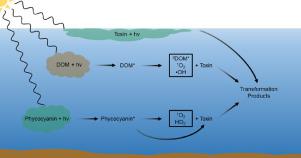Water Research ( IF 12.8 ) Pub Date : 2021-01-04 , DOI: 10.1016/j.watres.2021.116804 Tyler Kurtz , Teng Zeng , Fernando L. Rosario-Ortiz

|
Cyanotoxin-producing harmful algal blooms (HABs) are a global occurrence and pose ecotoxicological threats to humans and animals alike. The presence of cyanotoxins can seriously harm or kill nearby wildlife and restrict a body of water's use as a drinking water supply and recreational site, making it imperative to fully understand their fate and transport in natural waters. Photodegradation contributes to the overall degradation of cyanotoxins in environmental systems, especially for those present in the photic zone of surface waters. This makes photochemical transformation mechanisms important factors to account for when assessing the persistence of cyanotoxins in environmental systems. This paper reviews current knowledge on the photodegradation rates and pathways of cyanotoxins that can occur over the course of HABs. Sensitized, or indirect, photolysis contributes to the degradation of all cyanotoxins addressed in this paper (anatoxins, cylindrospermopsins, domoic acids, microcystins, and nodularins), with hydroxyl radicals (•OH), excited triplet states formed from the absorption of light by dissolved organic matter (3DOM*), and photosynthetic pigment sensitized pathways being of primary interest. Direct photolysis pathways play a less significant role, but are still relevant for most of the cyanotoxins discussed in this paper.
中文翻译:

地表水中氰毒素的光降解
产生蓝藻毒素的有害藻华(HAB)是一种全球性事件,对人类和动物均构成生态毒理威胁。氰毒素的存在会严重损害或杀死附近的野生动植物,并限制水作为饮用水供应和娱乐场所的用途,因此必须充分了解其在天然水中的命运和运输。光降解有助于环境系统中蓝藻毒素的整体降解,特别是对于地表水的光合带中存在的那些毒素。这使得光化学转化机制成为评估环境系统中氰毒素持久性的重要因素。本文综述了有关HABs过程中可能发生的氰毒素的光降解速率和途径的最新知识。敏感的或间接的3 DOM *),而光合色素敏化途径则是首要关注的问题。直接光解途径的作用较小,但仍与本文讨论的大多数蓝藻毒素有关。



























 京公网安备 11010802027423号
京公网安备 11010802027423号